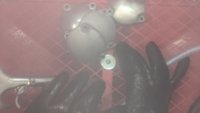Got the blaster up and running, no air solenoid yet using a ball valve to control the air. It’s a bit tricky using one hand in the glove and the other out.
It took some time to get the air needle right, at the moment it has a 2.5 mm hole and a 10 degree taper at the end. It looks nothing like the one in the YouTube clip but works well.
Also fitted a back flow check valve I decided I needed to when during testing I saw slurry coming back out a disconnected air line.
It took some time to get the slurry pump positioned so that there was minimal dead media building up in the bottom of the slurry tank.
It appears to be faster than bead only blasting and after a hose down it looks good right out of the cabinet. I used to spend a fair bit of time burnishing the bead blasted surface so that it did not show finger marks.
The glove seals leak a bit where they fix to the cabinet but apart from that no leaks (so far).
All in all I am calling this experiment a success.
Just as well because I have decided to clean another set of cases and choose the best or least worse for a new scheme.
Some before and after photos. It really needs another quick going over to get the finish consistent .


It took some time to get the air needle right, at the moment it has a 2.5 mm hole and a 10 degree taper at the end. It looks nothing like the one in the YouTube clip but works well.
Also fitted a back flow check valve I decided I needed to when during testing I saw slurry coming back out a disconnected air line.
It took some time to get the slurry pump positioned so that there was minimal dead media building up in the bottom of the slurry tank.
It appears to be faster than bead only blasting and after a hose down it looks good right out of the cabinet. I used to spend a fair bit of time burnishing the bead blasted surface so that it did not show finger marks.
The glove seals leak a bit where they fix to the cabinet but apart from that no leaks (so far).
All in all I am calling this experiment a success.
Just as well because I have decided to clean another set of cases and choose the best or least worse for a new scheme.
Some before and after photos. It really needs another quick going over to get the finish consistent .

